sludge end uses
Reading time:sludge end uses
Sludge produced by a water treatment plant has three main uses:
- recycling: mainly agriculture, with or without supplements but also for reinstating eroded sites (quarries, roadway excavations, replanting landfill sites…), in forestry and urban landscaping applications. Recycling means that the main elements making up sludge (carbon, nitrogen, phosphorus) can be re-incorporated via the soil into the major geochemical cycles by using their fertilising potential;
- elimination or destruction of OM with recycled energy using thermal processes (dedicated incineration or co-incineration, pyrolisis/gasification, wet method oxidation, see dewatered sludge treatment): every attempt is made to oxidise the organic matter contained in sludge as comprehensively and cost-effectively as possible in such a way that all that remains to be recovered is an ultimate mineral residue. Depending on applicable regulations, this residue can be recycled in materials engineering or disposed of at a landfill site with or without the obligation of rendering it inert depending on the results of leaching tests;
- disposal at a landfill site: also known in France as a "technical landfill centre" or, more recently, as a "waste storage centre". There are three types of landfill sites in Europe: class 1 for hazardous waste ( or "special industrial waste"), class 2 for household and similar waste and class 3 for inert waste.
treatment restrictions associated with end usage
for recycling
- agricultural spreading of non-stabilised dewatered sludge will no longer be an option; stabilisation (digestion, lime treatment, composting, extensive drying) has become compulsory;
- sludge sanitisation, although not compulsory at present in France, is being increasingly demanded on grounds of health (USA, United Kingdom).
- major and costly storage capacities will be required, covering a period of 6 to 9 months according to the case, and even longer, with a batch management system to ensure traceability. On a cost-effective level, this issue justifies processes that will reduce the tonnage of sludge to be stored. Such as Biolysis, drying and/or thorough stabilisation through composting, for instance;
- recycling will be prioritised when a structured sludge is discharged by the plant (avoid systems that produce a paste-like or sticky sludge).
- finally, care needs to be taken to design a sludge dewatering and treatment system that provides a back-up disposal system when the sludge can no longer be used for agricultural spreading (landfill site, incineration…).
sludge disposal
Sludge disposal processes involving thermal destruction (incineration, wet system oxidisation, pyrolisis) have tended to develop as the result of increasingly demanding statutory constraints, poor social acceptance of recycling and, therefore, the lack of a medium to long term vision of the recycling system.
In any case, regulations on flue gas treatment will have to be satisfied and these regulations are becoming harmonised throughout Europe (see dewatered sludge treatment).
Concerning dedicated incineration, the highest possible dry solids content must be sought through mechanical dewatering (by attempting to significantly reduce mineral conditioning) in order to reduce or even eliminate consumption of to-up fuel together with the flue gas output that has to be treated. The choice of this system must also provide guidelines when selecting the water treatment system in order to obtain sludge that is rich in VM and that has a high dry solids content (high net calorific value).
disposal in a landfill site
The increasingly high costs involved in disposing of sludge in a landfill site (60 to 90 euros per tonne at a class 2 Technical Landfill Centre, 180 to 275 euros per tonne at a class 1 Technical Landfill Centre) is making this a less and less competitive method of disposal. Maximum tonnage reduction through appropriate treatments (drying, wet oxidisation method, incineration…) is now becoming a necessity. In Europe, directive 1999/3/EC of the 26th April 1999 described the national strategies that needed to be put in place in order to programme, by 2015, a gradual reduction of the amounts of biodegradable community waste such as sludge (non ultimate waste) disposed of to landfill sites.
A knowledge of the local context and of the statutory constraints associated with each end use constitutes a compulsory step in the satisfactory design of a sludge treatment system: this has led us to provide below an overview of the main European and USA legislations addressing these end uses.
regulations on end use
regulations on the disposal of sludge produced by water treatment plants
(please also refer to the www.europa.eu site for texts on this European legislation and the www.journal-officiel.gouv.fr site for information on French legislation)
National legislation addresses sludge disposal problems via two logics:
- a "sludge = waste" logic;
- a "sludge = product" logic.
The «waste» approach does not exclude sludge recycling (for agricultural or heating purposes) but strongly supports these applications. However, there are wide variations depending on the country concerned, especially with regard to limit micro-pollutant thresholds:
- In France, the "sludge = product" approach is governed by approvals and standards.
The law of the 13th July 1979 sets three mandatory authorisation criteria for products intended to be supplied free-of-charge or sold as a fertiliser or growth medium:
- the product must be harmless to Man, animals and the environment;
- the product must be agronomically effective;
- the product’s composition must be consistent (stable, unchanging, homogenous).
The order of the 21st December 1998 (Official Gazette of the 12th February 1999) describes the formalities involved in submitting a product for authorisation. Based on a technical and administrative dossier, the Ministry for Agriculture can deliver:
- a certification (when all three criteria are met);
- a provisional sales or import permit, or continue to examine the dossier or deny its certification,or continue to examine the dossier or deny its authorisation.
In December 1998, the Ministry for Agriculture circulated a guide detailing the various formalities involved in lodging an application for for certification. By the end of 2003, few dossiers had been granted a certification or a provisional sales permit; of these, we should quote the case of the residual sludge from the town of St Brieuc in France (digested sludge produced by a Naratherm dryer and sold under the Ferti’Armor brand name) together with two sludge composting plants constructed by SUEZ at Castelnaudary (France) and the Clairefontaine paper mill in the Vosges (France).
Sludge and its by-products can be processed for re-use as fertilising matter in one of two other ways:
- sludge satisfies a standard that is mandatory (see below standard NFU 44 095);
- sludge is covered by an agricultural spreading plan according to the law on water or to the law on classified installations (see below the decree of December 1997 and the associated order of January 1998).
- in Europe, management of waste in general and of residual sludge in particular has been developed along two lines:
- a "soil" approach: soils in general must be safeguarded by taking their organic matter requirements into consideration but also by restricting micro-pollutant inputs;
- an "organic waste recycling" approach where two draft directives are currently being prepared ("compost and sludge used in agricultual spreading" and "biowaste and sludge used in agricultual spreading" draft directive). The first of these drafts aims to establish 3 categories of compost according to the properties of each of these categories and to impose restrictions on use according to the category concerned.
- American regulations promote the agricultural recycling of sludge ("biosolids") as a matter that has fertilising potential and as a product that can be sold in the same way as any other chemical fertiliser. Accordingly, EPA regulations (40 CFR-Part 503) divide sludge into two categories: class A sludge subject to few restrictions with regard to its use for agricultural spreading and class B sludge, of a lesser quality, subject to more severe usage restrictions (see sludge sanitisation);
- main Community and French texts on waste and sludge management
european directives
- Directive 75/442/CEE of the 15th July 1975 on waste (obligation and responsibility incumbent on the producer and keeper of waste, obligation of information, penalties applicable if these obligations are not performed).
- Directive 86/278/CEE of the 12th June1986 (currently being revised) on the protection of the environment and especially soils when using water treatment sludge in agricultural applications, amended by.
- Directive 91/692/CEE of the 23rd December 1991 on the standardisation and rationalisation of reports concerning the enactment of certain directives concerning the environment.
- Directive 91/271/CEE of the 21st May 1991 on the treatment of urban wastewater.
- Directive 91/676/CEE of the 12th December 1991 on protecting water from nitrate pollution created by agricultural practices.
- Directive 91/689/CEE of the 12th December 1991 on hazardous waste.
- The Community list of waste matter (Decree n° 2000/532/CE of the 3rd May 2000): list of waste matter drawn up through the implementation of Directive 75/442/CEE on waste and Directive 91/689/CEE on hazardous waste. Sludge comes under heading 19 on "waste produced by waste processing plants, off-site wastewater treatment plants and the water industry".
european directives on landfill sites
- Council Directive 1999/31/EC of the 26th April 1999; 3 categories of landfill sites: on hazardous/non-hazardous/inert waste.
Note: the French law of July 1992 on the disposal of waste to landfill sites could be interpreted as a ban on disposing of sludge in this manner from July 2002. This interpretation has been rejected by the Ministry for the Environment as it was due to a misunderstanding created by the term. «ultimate waste». The aforementioned directive does not prohibit disposal to a landfill site but sets a plan for reducing the quantities of biodegradable waste that will be accepted at landfill sites by 2015. However, other countries including Germany speak of prohibiting disposal to landfill sites by 2005.
european directives on incineration
Directive 2000/76/EC of the 4th December 2000.
french regulations
- a. Texts on ICPE (Installations classified with regard to protecting the environment)
Law n° 76-663 of the 19th July 1976 on the ICPE applies to plants that produce waste and to waste elimination plants that are themselves ICPE.
- b. Texts on disposal to landfill sites
Legislation on the disposal of waste to landfill sites identifies:
- Special industrial waste or SIW (classified and identified by the decree of the 15th May 1997 and which will shortly include the new European waste catalogue published in January 2001) intended for disposal to category 1 landfill sites and which include;
- waste incineration residues (fly ash, fines, flue gas processing waste);
- sludge produced from certain industrial wastewater;
- the order of the 18th December 1992, as amended by the order of the 18th February 1994, regulates the disposal of special industrial waste to landfill sites;
- household and similar waste or HSW intended for disposal to category 2 landfill sites (official name: CSDMA = Household and assimilated waste storage centre); sludge produced from urban wastewater is deemed to constitute Household and Similar Waste unless it has a high toxic matter content. The order of the 9th September 1997 regulates disposal to class 2 landfill sites; this order was amended by the order of the 31st December 2001 to take into account the European Directive 1999/31/CE but has no effect on urban wastewater sludge;
- inert waste stored on category 3 landfill sites.
- c. Texts on incineration or co-incineration
Transposition of directive 2000/76/EC into French law by the orders of the 20th September 2002 with regard to hazardous and non-hazardous waste produced by incineration and co-incineration (see also dewatered sludge treatment).
- d. Texts on the agricultural recycling of urban sludge
- decree n° 97-1133 of the 8th December 1997 (Official Gazette of the 10th December 1997) on the agricultural spreading of sludge produced by wastewater treatment and mainly establishing as follows:
- this sludge must be treated as waste (article 2). Sludge spreading falls within the scope of article 10 of the law on water n° 92-3 of the 3rd January 1992; therefore, this function will be subject to authorisation or declaration;
- this decree does not include the following products (refer to certification and standardisation above);
- the waste generated by the cleaning of collection systems can only be used for agricultural spreading after grit and grease removal;
- agricultural spreading of grit and grease is prohibited;
- nightsoil produced by non-collective systems must be treated like sludge;
- before being used in agricultural spreading applications, sludge must have undergone a treatment (physical, biological, chemical, thermal, long-term storage or other as appropriate) intended to reduce its ability to ferment as well as the health risks associated with its use;
- the need for a preliminary study carried out by the producer to ensure that the soil is suitable for taking this sludge;
- "field edge" storage rules implementing spreading periods and limiting nuisances;
- arrangements for a back-up sludge removal solution;
- the need to keep a record of the provenance, origins and properties of the sludge spread, of the dates on which the spreading was carried out, of the quantities per plot and the crops grown;
- sludge spreading must be compatible with soil properties and with plant nutrient requirements;
- the sludge producer must provide the prefect with a provisional spreading schedule and with an annual agronomic report;
- spreading is prohibited during certain periods of the year and on certain sensitive terrains;
- this decree also applies to spreading on woodland plots or for reforestation, subject to the publication of the relevant orders (unpublished to date);
- the order of the 8th January 1998 published in the Official Gazette of the 31st January 1998 and amended by the order of the 3rd June 1998 (Official Gazette of the 30th June 1998). The purpose of this order was to establish the technical specifications applicable to the spreading of sludge on agricultural land; this order constitutes the enactment of the previous decree of the 8th December 1997 and provides definitions of solid, stabilised and sanitised sludge. Trace element levels (metal and organic) have been given in tables 72 and 73. On sanitised sludge, the order establishes maximum levels for certain micro-organisms (salmonella, enterovirus and viable helminth eggs); restrictions on sanitised sludge spreading have been lightened. The order establishes spreading distances based on the nature of the activities that have to be protected. The order describes the elements used to identify the agronomic value of sludge, analysis frequencies according to the tonnage to be spread, sludge and soil sampling methods;

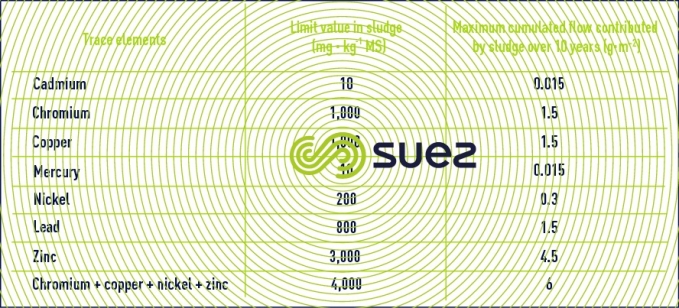


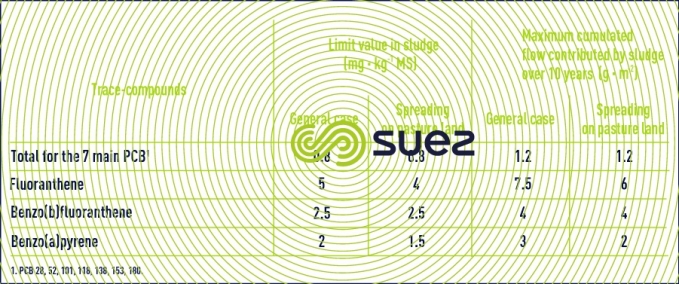

- order of the 2nd February 1998 (articles 36 to 42) enacting law 76-663 of the 19th July 1976; this order defines the conditions governing the spreading of sludge produced by Installations classified for the protection of the environment. The order consitutes the obligation to undertake an impact analysis, to raise a spreading programme and to carry out follow-up sludge analysis;
- order of February 1998 (Official Gazette of the 12th February 1998): this order abrogates the compulsory application of standard NF U 44-041 of July 1985 on fertilising matter and on sludge taken from urban wastewater processing structures.
- e. French standards
Standard 44 – 095: this standard establishes the requirements to be met with a view to marketing organic soil improvers using matter of agronomic value produced from water treatment (MAV-WT) and, therefore sludge compost that is of value as fertiliser for crops, soil maintenance or improvement.
Organic soil improvers must be prepared from a blend of MAV-WT and a plant matter type co-component. This mixture must then undergo an aerobic type (composting) or anaerobic type process followed by an aerobic stage. Grease, grit, cleaning or bar screening waste cannot be regarded as MAV-WT.
This standard is covered by articles L.255-1 to L.255-11 of the Rural Code (replacing law n° 79-595 of the 13th July 1979 on the inspection organisation responsible for crop support and fertiliser matter). These articles define the conditions applicable to the marketing of fertiliser matter and crop supports, based on effective and harmless utilisation conditions. The purpose of this standard is to establish the denominations, definitions and specifications, marking, and the data identifying composts containing MAV-WT. The standard specifies the properties of the end product in terms of OM, DM and organic OM/N as well as N, P2O5 and K2O values. The requirement concerning the harmless nature of the product will be satisfied when the limit figures for trace metal elements, trace organic compounds and micro-organisms have been met.
The NFU 44 095 standard was approved in May 2002 and the order for its compulsory implementation was published in March 2004.
regulations on sludge sanitiSation
Sanitisation is the general term given to operations used to reduce all pathogenic micro-organisms initially found in sludge, to harmless levels (France, order of the 8th January 1998 on the agricultural spreading of water treatment sludge, articles 12 and 16); these pathogenic agents primarily belong to organisms of the following types: bacteria, viruses, actinomycetes, protozoa and helminths.
Different legislation (local, national, Community) on the use of sludge for storage or recycling purposes, establish criteria used to achieve sanitisation standards. It would be time-consuming to restate these criteria at this point on a country-by-country basis. Nevertheless, we must quote legislation used as references in this field and, in particular, American and French regulations.
american regulation (40 CFR – PART 503)
(visit www.epa.gov)
This regulation establishes 2 categories of sludge (biosolids A and B) that are also required to satisfy criteria designated carrier attraction reduction (animals capable of being carriers of infectious agents after coming into contact with sludge; these animals include mosquitos, flies, rodents…).
class A sludge (table 74)
This sludge is not subject to any restriction when used in agricultural applications and may be sold. It should be noted that some options (5, 6) define methods to be used and not the results to be achieved.
In order to qualify as "Class A sludge", at least one of the six alternatives must be satisfied while at the same time and in any case complying with limit values for faecal coliforms and salmonella.

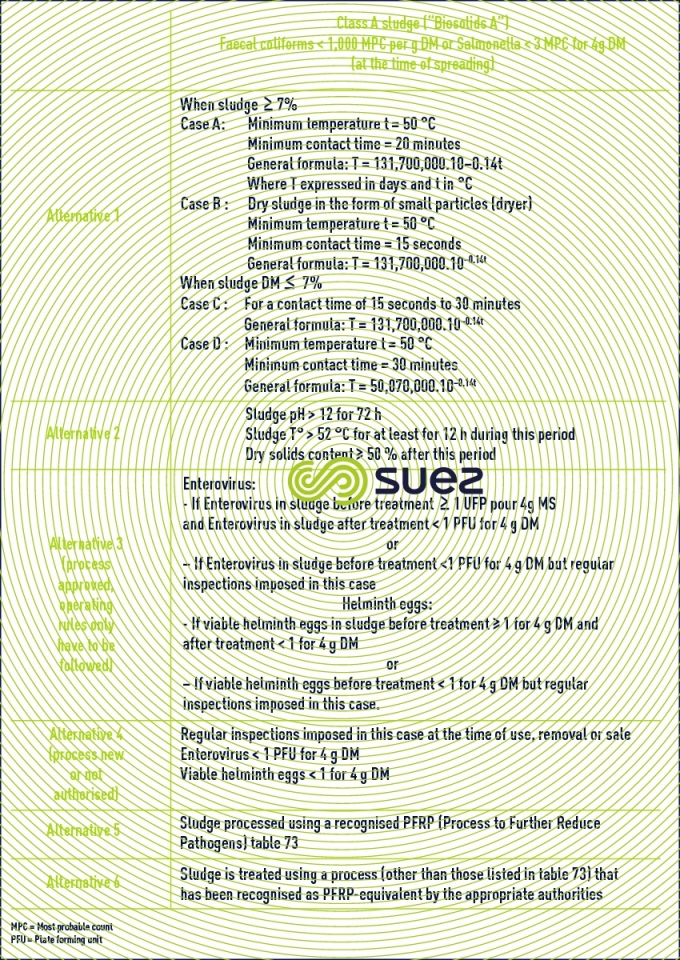


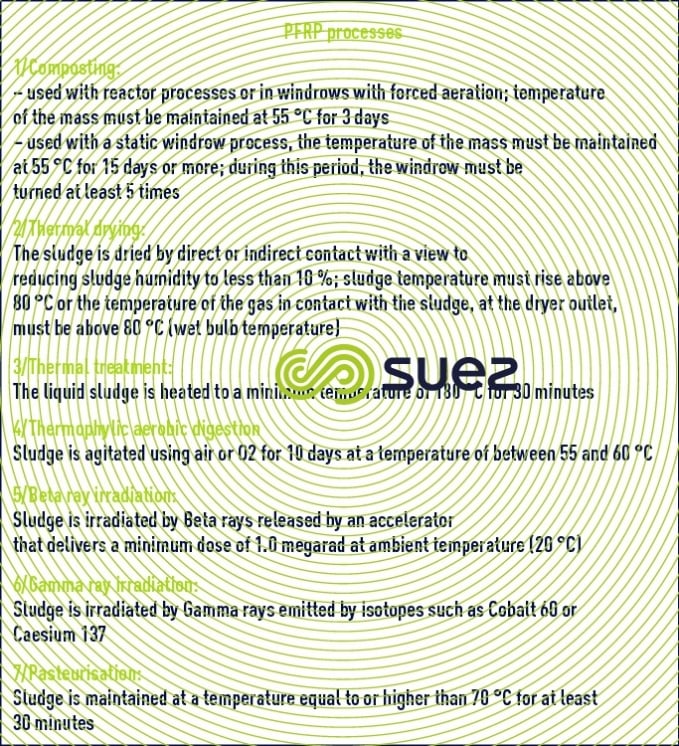

class B sludge (table 76)
This sludge may neither be marketed nor used in communal areas (gardens, lawns…); the treatment applied to this type of sludge will eliminate part but not all of pathogenic organisms.

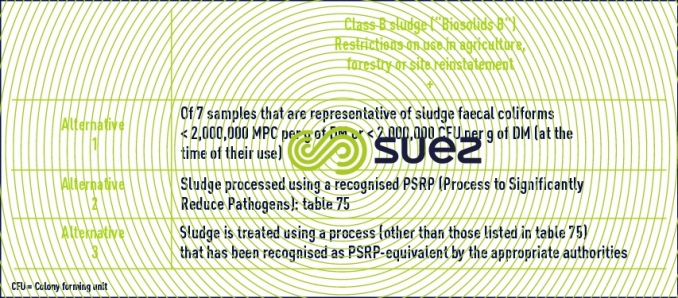


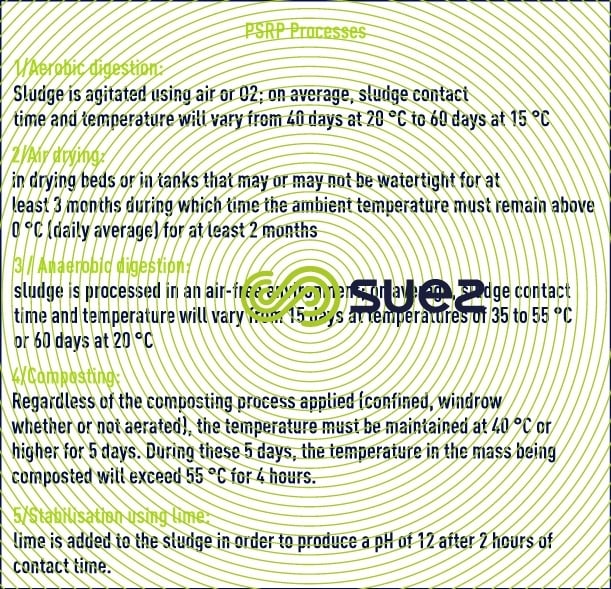

"carrier" attraction reduction
There are eleven means (alternatives) that can be used to reduce sludge’s attraction for these animals. These means are listed in table 78 (means required are extra to those detailed under the "alternatives" in tables 1 and 3).

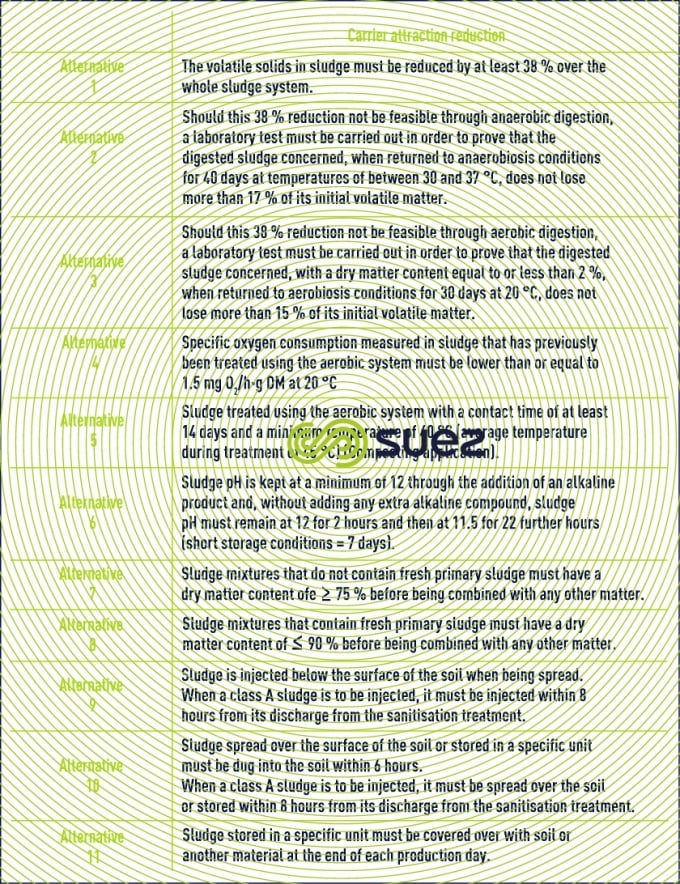

In addition, the EPA 40 CFR – Part 503 regulation refers to the analysis methods that must be used and to the frequency of these analyses according to plant size.
One important point to be borne in mind is the need to use processes that have been granted class A or B equivalence in such a way that the entire sludge mass is treated; this implies that the reactors have to be operated in integral plug flow mode or in batches.
french and european regulations
The order of the 8th January 1998 does not ban the spreading of non-sanitised sludge. However, it does impose restrictions on the use of non-sanitised residual sludge (distances to be implemented from dwellings, water outlets, waterways, waiting times to be implemented prior to market garden crops, animal pastures…
This order took into consideration the recommendations made by the Superior Council for Public Health in France (CSHPF); in table 79, this order is compared with the demands set by the future European directive (if the draft remains unchanged).

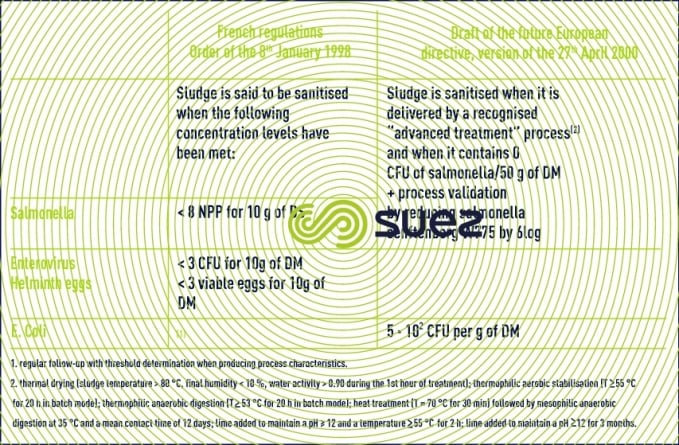

Bookmark tool
Click on the bookmark tool, highlight the last read paragraph to continue your reading later












